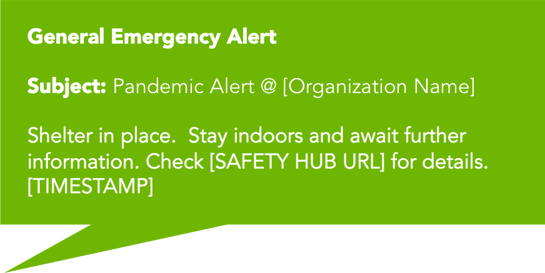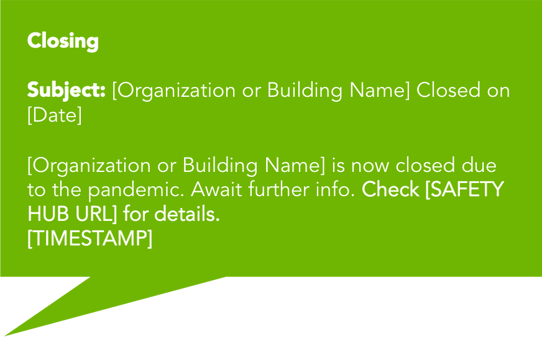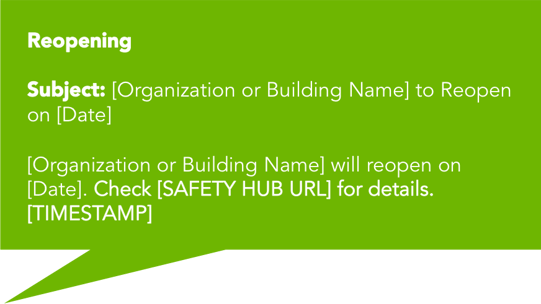Times like these can leave you speechless. As much as you plan for emergency situations, there is still an element of surprise when something happens that you've never experienced before in your lifetime. Pandemic communications templates will enable you to plan for continued emergency notifications during and after the coronavirus crisis, as well as help you to strategically prepare for future events. Emergency preparedness ensures quick and reliable execution when the time comes.
“Disease outbreaks are inevitable, and often unpredictable, events. The environment surrounding an outbreak is unique in all of public health. Outbreaks are frequently marked by uncertainty, confusion, and a sense of urgency. Communication, generally through the media, is another feature of the outbreak environment. Unfortunately, examples abound of communication failure which have delayed outbreak control, undermined public trust and compliance, and unnecessarily prolonged economic, social, and political turmoil. The World Health Organization (WHO) believes it is now time to acknowledge that communication expertise has become as essential to outbreak control as epidemiological training and laboratory analysis.”
—WHO Outbreak Communication Guidelines
There is no doubt that during this pandemic your organization will have a need for emergency communications and alerts. A pandemic can affect many areas of the business and the communications process can make or break your reputation. It can influence how stakeholders ultimately react to the incident. Communication is critical in keeping your people safe and minimizing the potential negative impact of the event. As you know, your people are your most valuable asset.
While the coronavirus pandemic may have come about unexpectedly, it is never too late to plan. During emergencies such as these, you will be better equipped to address the well-being of your people if you prepare. The success of your emergency response is dependent on proper preparation.
When you need to deliver critical messages, make sure they are already in the queue. Part of your planning process should include drafting pandemic communications templates to enable your team to respond quickly and limit potential errors. Speed and accuracy will determine the effectiveness of your communications.
Creating Your Pandemic Communications Plan
Pandemic planning can help to reduce the spread of the virus, the number of cases, and the economic and social impact. Lack of continuity planning can be extremely damaging as you attempt to address the pandemic challenges with limited resources.
As mentioned in our Pandemic Communications Best Practices blog post, you should be proactive in communicating with your stakeholders in the early stages of the pandemic lifecycle. Planning will enable you to be proactive and can have a big impact on how your people perceive and respond to the pandemic. It will also help you to respond in a focused and strategic manner.
Take the following steps as you develop your comprehensive pandemic communications plan:
1. Determine the proper channels or modes to get your message out. You can disseminate information through a variety of ways. The success of your communications will depend on determining the most appropriate methods of dissemination for your particular target audience. The key is to identify which vehicle will get your critical information out quickly and accurately.
2. Select credible resources from which you will rely on for new information. If possible, try to identify which resources you will leverage PRIOR to any crisis situation. Additionally, consider involving community planners and integrating your plan into local and state plans. You may be able to leverage the resources of local community planners to support your efforts in keeping your people safe and informed.
3. Prepare your first notification (see general emergency alert below). Your stakeholders will likely expect to receive communications on recommended actions as soon as the news of a potential pandemic breaks. It is critical for you to make sure your communications are clear, accurate, credible, and consistent. Ensure the information released is the same across all platforms. Inconsistent messages increase anxiety and skepticism.
4. Establish procedures for sending updates. You will need to develop a process for how to provide new information to your audience. It is important to keep all stakeholders informed of the progress, especially if they are unable to be on-site. Regular updates on the actions being taken will instill confidence.
5. Develop your talking points. It is helpful to lay out your key messages, specific talking points, and supporting information in advance.
Planning and preparing what you are going to say is absolutely essential in emergency situations. It will save you time in the long run, which will enable you to focus your efforts on other mission critical responsibilities. Additionally, drafting pandemic communications templates will provide you with more time for proofreading and optimizing the content for maximum readability and comprehension. Pre-written and pre-approved notifications will help to prevent panic. The general outline of your communications plan can then be reused in other emergency situations.
You will be able to instantaneously send your messages to the masses by utilizing emergency notification scripts written into templates. The messages can be drafted for specific groups within your school or organization, as well as for various issues that may arise. For instance, you may create a template to announce when particular buildings on your campus will close or reopen.
Determining Modes for Pandemic Communications
Now is the time to assess your available emergency communication systems and technologies. You may want to explore enhancing and procuring a more robust system.
There are a variety of ways to send emergency alert messages. Text and email are probably the most popular. Whether you are conscious of it or not, most of us are now in the habit of checking our text and email quite regularly. These channels are the lifeblood of both social and corporate communication. These forms of communication are also key in disseminating information during a crisis.
Evaluate the types of incidents that may occur during a pandemic to help determine the best channels to deliver your messages. The various modes of communication may require the messages to be crafted differently. Part of your planning process should include deciding on the most appropriate and effective channel(s) to get your message out. For instance, you may choose to employ text messages for maximum immediacy and reach. Text messages should be kept relatively short, but you can direct the recipient to a URL with additional information. Voice calls can also be used for short, concise messages and can be especially helpful if you are unsure of your audience's access to text message functionality. For slightly less urgent or more extensive messaging, you may choose to use email or social media feeds. There are also ways to integrate your emergency notification system with special hardware like signs and alarms.
3 Sample Pandemic Communications Templates
If possible, you will want to predefine your risk communications messages. We've used our emergency communications background, as well as input from our partner organizations, to develop a set of effective pandemic communications templates. These particular messages are geared more for delivery via text message.
When preparing your templates, consider the various events that may occur throughout the lifecycle of the pandemic and the key messages you will need to get across to your stakeholders when those events occur. Draft tailored pandemic communications to address all the phases of the pandemic, including recovery.
The first step is to develop a general emergency alert message template. This message will provide you with a wide degree of coverage for many situations, including those you may not necessarily anticipate. Use the template below as a starting point for your own general emergency message template.

Closures are likely necessary as the risk increases in large gatherings. Let your people know as soon as a decision is made on closings to help prevent confusion and provide them with time to reassess and reschedule their plans. You may want to create a template to announce those closings, such as the one below.

Finally, everyone's favorite, a pandemic communications template to announce all is clear! You will want to let everyone know when the pandemic has been contained and when they can return to work, school, and previously scheduled activities.

You may also consider drafting templates for general awareness of preventative measures, new diagnoses, travel restrictions, and monitoring those who are ill or suspected to be ill. Additionally, don't forget to notify external stakeholders of restrictions on your premises and the alternative procedures.
4 Key Components of Pandemic Communications Templates
Messages should be concise and specific to keep those you care about safe and informed. Whether it is a general alert or a closing/reopening announcement, you will need to get the word out in a calm and collected manner.
When drafting a pandemic communications template, there are four key components to increase the effectiveness of your message and keep your people safe:
1. Keep it brief and to the point. Use as few words as possible to communicate the most critical information. Your message should instantly inform your stakeholders of exactly what they need to do. Use very direct words that are easy to understand, while trying not to cause panic. Initiate the instructions that have been previously used with your people during training exercises.
2. Be specific with directions, but general with information. When an emergency situation arises, you don't always have all the details right away. In fact, some of the information you have may be inaccurate and the last thing you want to do is send out misinformation. What is most critical is to direct your stakeholders to safety without causing any unnecessary confusion.
3. Include a timestamp. This simple, automated feature may actually be more important than you think. A timestamp will confirm the message is in real-time and inform your people that it could be outdated if they read it at a later time. This will help to prevent confusion when executing your pandemic communications plan.
4. Link to a Safety Hub URL. Ideally, your school or organization should already have a webpage that people can access at anytime from anywhere with all of the latest emergency updates and preventative tips. The webpage provides a platform for delivering more detailed information that may not fit in a text message or email. You can also include links to external resources that may be helpful. Those in charge of safety should be able to easily access and edit the webpage. Your audience should also be trained on how to access and use it. This will ensure everyone is always up to date with the most recent information at any given time.
Refining Pandemic Communications Messaging
As you continue to develop your messaging, be mindful of how your audience is perceiving the risk and responding to your pandemic communications. At-risk groups, testing availability and distribution may change over time and that information needs to be shared as it is received. Assess your predefined messages and alter them as necessary for changing conditions.
All public health emergencies present risk communication challenges and this coronavirus pandemic isn't any different. Listening to and addressing concerns is key in effective messaging. Monitor ongoing developments and refine your messaging by:
- Regularly watching, reading, and listening to the news
- Evaluating how the news is presented
- Learning from the communication successes and pitfalls of others
- Addressing misinformation quickly
Conclusion
Essentially, the main goals of your communications plan should be to:
- Reduce the spread of the pandemic virus to employees, customers, students, partners, etc.
- Minimize the illness itself among your stakeholders
- Maintain operational business continuity as much as possible
- Minimize the overall economical impact of the pandemic
These pandemic communications templates can provide coverage for a variety of issues over a period of time. Once in place, you can you can use the templates to build specific messages, as necessary, to increase the effectiveness of your emergency communications plan. As you create your own templates, it is important to keep in mind the four key components outlined above to make communications clear and minimize confusion. It will be exciting to send out the final "all clear" message notifying everyone they can resume normal activities.
With this information you are now ready to create effective pandemic communications templates and further ensure the safety of your people. While you can't predict the future, at least you can do your best to proactively prepare for it.
Click here to read the Definitive Guide to Pandemic Communications

